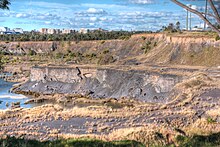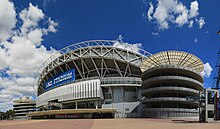Homebush Bay
| Homebush Bay Federal division(s) | Reid | ||||||||||||||
|---|---|---|---|---|---|---|---|---|---|---|---|---|---|---|---|
| |||||||||||||||

Homebush Bay is a
The bay has a natural and artificial shoreline on the southern side of the Parramatta River between the suburbs of Wentworth Point and Rhodes. In the 1900s the bay was contaminated with dioxins and other chemicals by the local Union Carbide chemical plant, which has led to commercial fishing bans in most of Sydney Harbour, and health advisories about limiting the quantity of fish eaten from the Parramatta River. Other contaminants in the bay include phthalates, lead, polycyclic aromatic hydrocarbons, DDT, and heavy metals.[1] The eastern shore of the bay was remediated starting in 2008 to remove about 75% of the dioxins from the bay. Remediation was completed in mid-2010, however fishing is still prohibited in Homebush Bay.
The western shore of Homebush Bay is in the local government area of the City of Parramatta, while its eastern shore is in the City of Canada Bay. As a result, the bay forms part of the geographical boundary between the Greater Western Sydney region in the west and the Inner West region of Sydney in the east,[2] except that the suburb of Wentworth Point, at the northern tip of the western bank, is sometimes marketed as being in the Inner West.[3]
History
The region is a part of the traditional land of the Wann-gal people who lived in Homebush Bay thousands of years ago and survived on the resources offered by the estuary. The first European settlers arrived here in 1793 and declared the land as 'Flats' whose grants were given to free men. For this reason, it came to be known as the 'Liberty Plains'. The land was dominated by two families during this period - the Blaxlands and the Wentworths.[4]
The Home Bush Estate was established in the 1800s by the colony's assistant surgeon
Wentworth Point, the point on the western extremity of the bay, and Wentworth Bay, the nearby inlet on the western shore of Homebush Bay, are named after the Wentworth family - the bay has now disappeared due to land reclamation.[8] Mud Island was an island in the bay, which became connected with the western mainland due to land reclamation.[9]
In the 20th century, Homebush Bay became a centre of heavy industry, with large scale land reclamations to accommodate industrial facilities. When industrial operations scaled down, the bay became a dumping ground for a large range of unwanted material - from waste to broken up ships, even toxic industrial waste. Union Carbide had manufactured chemicals, including Agent Orange, on the site and dioxins produced as a by product were buried in landfill or left in drums.[10]
A drive to regenerate and rehabilitate the bay began in the 1980s. This led to the construction of
Suburb name change
The former
Hydrography



Homebush Bay is located on the southern shore of Parramatta River. Immediately to the east is Bray Bay, which is separated from Homebush Bay by a narrow peninsula (considerably expanded through land reclamation) that forms the suburb of Rhodes. It is across the Parramatta River from Meadowbank. It is the westernmost of the major bays on the Parramatta River.
Several tributaries enter Parramatta River at Homebush Bay: Powells Creek is joined by tributaries Boundary Creek and Saleyards Creek not far from the southern shore of the bay, and flows into the bay from the south, while Haslams Creek joins the bay further to the north.
The shoreline of Homebush Bay is in large parts artificial, with large scale land reclamations for industrial purposes occurring throughout the 20th century. Its history of use for industry and as dumping ground has left the bay heavily contaminated, including with dioxin and other chemicals produced by Union Carbide operations. Fishing is prohibited in Homebush Bay for health reasons. Other contamination includes phthalates, lead, polycyclic aromatic hydrocarbons, DDT and heavy metals.[13] Remediation from 2008-2010 removed about 75% of the dioxin from the bay.
A number of ships' hulls are visible in Homebush Bay, remains of the
Landmarks

Sydney Olympic Park is a 640 hectares (1,600 acres) area to the south west of Homebush Bay (and within the former suburb of Homebush Bay) which was notable as the site of the 2000 Olympic Games. Since then, there has been much development in the area including office buildings and apartments in the centre of Sydney Olympic Park. Three completed residential developments in the area are Newington, The Waterfront and Mariners Cove.
The
On the eastern shore, within the suburb of Rhodes, lies the large Rhodes Waterside shopping centre.
The Novotel Hotel features cafes, restaurants and bars with outdoor facilities that cater for special events held at Sydney Olympic Park.
Bennelong Bridge, a bridge open to pedestrians, cyclists and buses but not to cars, crosses the bay near its mouth (between Rhodes on the east bank and Wentworth Point on the west bank). The bridge opened on 22 May 2016. Between 2014 and 2016, during construction, the low bridge was protected by a "maritime exclusion zone", meaning that watercraft was not able to enter or leave Homebush Bay. [15]
Transport

Two stations on the
Sydney Ferries' Parramatta River ferry services run to the Sydney Olympic Park ferry wharf on the bay. Originally designed to service Sydney Olympic Park, the wharf now mainly serves the residents of Wentworth Point. Busways run a number of regular bus services to the area around the bay. There are also a number of Sydney Olympic Park bus routes for sporting events, concerts and other major events at the Sydney Olympic Park precinct such as the Sydney Royal Easter Show.
A light rail line is planned to be constructed on the western shore of the bay, which will connect Olympic Park railway station with the centre of Parramatta, to the west. The line was initially planned to run alongside the parkland on the southern shore and connect with Strathfield railway station, but in the current plans the line will terminate in nearby Lidcombe.
Culture
Events
- Sydney Showgroundat Homebush Bay.
Sport

For more information see Stadium Australia
- National Rugby League games including the Grand Final are played at Stadium Australia.
- NSW Blues).
- ING Cupmatches at Stadium Australia each season
- Los Angeles Galaxywhich drew a crowd of 80,000.
- V8 Supercarschampionship.
Pop culture
The Brickpit at Sydney Olympic Park was used as a location for the filming of
Gallery
-
Sydney Olympic Park hotels
-
Hill Road
-
Olympic Boulevard
-
The New South Wales Rural Fire Service headquarters on Carter Street.
See also
References
- ^ "Home - Homebush Bay Remediation". Archived from the original on 21 February 2012. Retrieved 31 October 2011.
- ^ Centre for Western Sydney - About the profile area
- ^ Domain - Wentworth Point Suburb Profile
- ^ "Sydney Olympic Park and Homebush Bay – A Brief History". Parramatta Heritage Centre.
- ISBN 0-207-14495-8, page 124
- ISBN 0-86861-407-6, page 15
- ^ Dictionary of Sydney - Homebush Bay
- ^ Dictionary of Sydney - Wentworth Bay
- ^ Dictionary of Sydney - Homebush Bay
- ^ Perry, Michael (10 February 2006). "Toxic Waste Ends Sydney Harbour Commercial Fishing". Reuters, Planet Ark. Archived from the original on 20 June 2006. Retrieved 13 April 2007.
- ^ "Auburn Council". Archived from the original on 13 October 2009. Retrieved 6 October 2009.
- ^ Leaflet, A New Suburb Name For Homebush Bay
- ^ "Home - Homebush Bay Remediation". Archived from the original on 21 February 2012. Retrieved 31 October 2011.
- ^ Blaxell, Gregory (May 2008). "The Wrecks of Homebush Bay". Afloat. AFLOAT Publications Pty. Ltd. Archived from the original on 5 May 2013. Retrieved 30 April 2013.
- ^ A new bridge to connect growing communities Homebush Bay Bridge
- ^ Bartertown Set for Mad Max: Beyond Thunderdome
External links
- Sydney Olympic Park website
- Edmund Perrin (2008). "Homebush Bay". Dictionary of Sydney. Retrieved 27 September 2015. [CC-By-SA]




